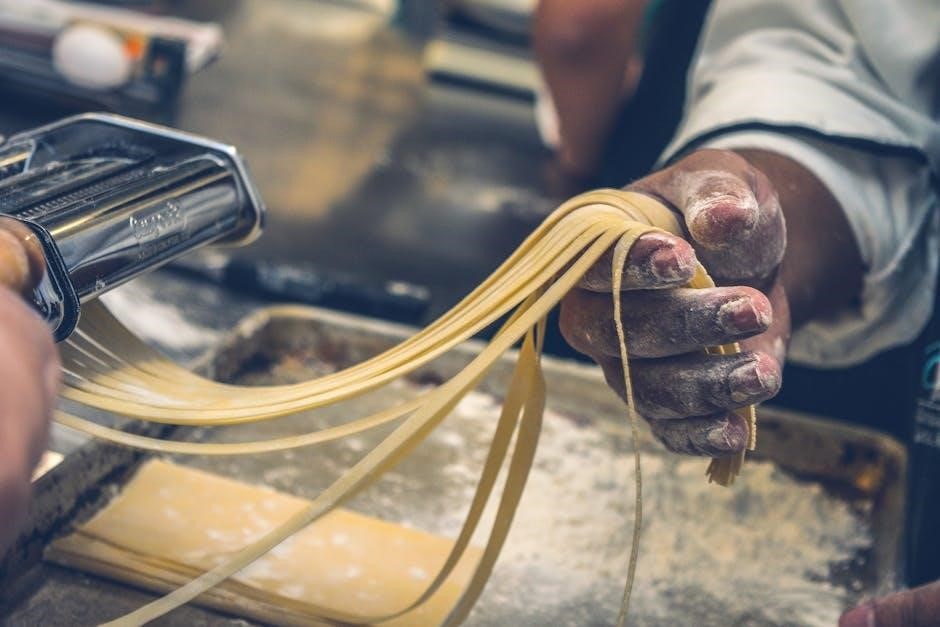The IS300 manual swap involves replacing the automatic transmission with a manual gearbox, enhancing driver control and performance․ It’s a popular modification among enthusiasts seeking a more engaging driving experience․
1․1 Overview of the IS300 Manual Swap
The IS300 manual swap involves replacing the factory automatic transmission with a manual gearbox, such as the W55 or W58, to enhance performance and driver engagement․ This modification requires specific components like a clutch, flywheel, and pedal assembly․ It also involves wiring harness adjustments and mechanical upgrades to ensure compatibility and functionality․ The process is popular among enthusiasts seeking improved control and driving dynamics․
1․2 Benefits of Converting to Manual Transmission
Converting the IS300 to a manual transmission enhances driver engagement and control, offering a more immersive driving experience․ It improves acceleration and responsiveness, making the car feel more agile․ Additionally, manual transmissions are often more cost-effective in the long run, with lower repair costs and better fuel efficiency․ This swap also appeals to enthusiasts seeking a more connected and rewarding driving experience․

Planning and Preparation
Planning involves assessing feasibility, budgeting, and gathering tools and resources․ Research transmission options, clutch components, and pedal assemblies to ensure a smooth swap process․
2․1 Understanding the Feasibility of the Swap
Understanding the feasibility of the IS300 manual swap involves assessing compatibility, researching required parts, and evaluating technical challenges․ Ensure the chosen transmission and components fit your vehicle’s specifications․ Consider the availability of OEM parts and potential modifications to the wiring harness and pedal assembly․ Some cars may require more extensive work than others․ A thorough inspection and consultation with resources or experts can help determine if the swap is viable for your specific setup․
2․2 Budgeting and Cost Estimation
Budgeting for an IS300 manual swap requires careful planning․ Transmission options like the W55 or W58 can range from $500 to $2,000, depending on condition and source․ Clutch and flywheel kits typically cost $300 to $800, while pedal assemblies and hydraulic components add another $200 to $500․ Additional expenses include labor, tools, and potential modifications․ Plan for $1,500 to $4,000 or more, depending on the scope and quality of parts․ Unexpected costs may arise, so allocate extra funds for contingencies․
2․3 Tools and Resources Needed
Performing an IS300 manual swap requires a variety of tools and resources․ Basic tools include wrenches, screwdrivers, and socket sets․ Specialized tools like a transmission jack, clutch alignment tool, and pressure bleeding kit are essential․ Additionally, access to repair manuals, online forums, and YouTube tutorials can provide valuable guidance․ Ensure you have a well-equipped workspace and consider professional help for complex steps․
Essential Parts for the Swap
The IS300 manual swap requires a manual transmission, such as the W55 or W58, a compatible clutch, flywheel, pedal assembly, and hydraulic components, ensuring proper fitment and function․
3․1 Transmission Options (W55, W58, etc․)
The W55 and W58 are popular manual transmission options for the IS300 swap․ The W55, known for its strength and reliability, is a common choice, while the W58 offers a sportier feel with closer gear ratios․ Both transmissions are compatible with the 2JZ engine, making them ideal for this modification․ Proper fitment and compatibility are crucial for a seamless swap․
3․2 Clutch and Flywheel Selection
Selecting the right clutch and flywheel is critical for the IS300 manual swap․ A single-mass flywheel is often preferred for its lighter weight, improving acceleration and reducing wear․ Clutch kits, such as those from the SC300, are popular for their durability and smooth engagement․ Proper alignment and compatibility with the transmission are essential for optimal performance and reliability․
3․3 Pedal Assembly and Hydraulic Components
The pedal assembly and hydraulic components are vital for smooth clutch operation․ A manual pedal box, clutch setup, and center console from a manual IS200/300 are required․ Hydraulic components, including the master and slave cylinders, must be compatible with the transmission․ Proper bleeding of the system is essential to ensure precise clutch engagement and avoid air bubbles, which can lead to performance issues․
Transmission Preparation
Transmission preparation involves thorough inspection, cleaning, and potential rebuilding or upgrades․ Ensuring the unit is in optimal condition is crucial for a successful manual swap using OEM components․
4․1 Inspection and Cleaning of the Transmission
Inspect the transmission for wear, damage, or contaminants․ Clean all components, including bearings, gears, and the case․ Replace any damaged or worn parts․ Ensure the unit is free from debris and properly lubricated․ This step is critical for a smooth manual swap and optimal performance․ Consult a specialist if unsure about any aspect of the process․
4․2 Rebuilding or Upgrading the Transmission
Rebuilding or upgrading the transmission ensures optimal performance for the manual swap․ Replace worn bearings and seals, and consider upgrading clutch packs or gear sets for enhanced durability․ Use OEM or high-quality aftermarket components to maintain reliability․ Ensure all parts are compatible with the IS300’s engine and drivetrain․ Proper preparation and alignment are crucial for smooth operation post-swap․ Consult a specialist for complex rebuilds․
Installation Process
Removing the automatic transmission and installing the manual gearbox requires careful disconnection of wiring, cooling lines, and drivetrain components․ Ensure proper alignment and secure mounting of the new transmission to maintain vehicle stability and performance․ This step is critical for a successful swap and requires precise attention to detail and mechanical expertise․
5․1 Removing the Automatic Transmission
Removing the automatic transmission involves draining the fluid, disconnecting wiring harnesses, and detaching cooling lines․ Support the transmission with a jack or lift, then remove the crossmember and mounts․ Carefully pull the transmission straight out, ensuring no damage to surrounding components; This step requires patience and mechanical expertise to avoid complications during the swap process․
5․2 Installing the Manual Transmission
Installing the manual transmission requires precise alignment with the engine’s bellhousing․ Secure the transmission using the factory mounts and crossmember․ Reconnect the driveshaft, wiring harness, and cooling lines․ Ensure all bolts are tightened to factory specifications․ Proper alignment and secure mounting are critical for smooth operation and to prevent damage․ This step completes the physical swap, preparing the car for clutch and pedal assembly installation․
5․3 Wiring Harness Modifications
Modify the wiring harness to adapt the manual transmission controls․ This involves integrating the clutch switch and reverse light circuit․ Repurpose existing automatic transmission wiring for manual operation․ Ensure proper connections for the gear position sensor and clutch pedal switch․ Consult a wiring diagram for accuracy․ Professional assistance is recommended for complex electrical modifications to avoid system malfunctions․

Clutch and Flywheel Installation
Install the new clutch and flywheel, ensuring proper alignment․ Choose between single-mass or dual-mass flywheels․ Align the clutch disc with the splines․ Secure the pressure plate․ Tighten evenly․
6․1 Removing the Old Components
Begin by disconnecting the battery to prevent electrical issues․ Remove the transmission and driveshaft to access the clutch and flywheel․ Take out the old clutch and pressure plate․ Remove the flywheel, ensuring not to damage the crankshaft․ Clean the area thoroughly to prepare for new components․ Use specialized tools for safe removal․
6․2 Installing the New Clutch and Flywheel
Install the new flywheel, ensuring it’s securely fastened with the correct torque specifications․ Align the clutch disc with the pilot bearing and press it into place․ Attach the pressure plate, tightening the bolts evenly in a star pattern․ Apply a thin layer of grease to the input shaft and pilot bearing for smooth operation․ Double-check all surfaces for proper alignment and cleanliness․

Pedal Assembly Installation
Install the clutch pedal assembly, ensuring proper alignment and secure mounting․ Connect the hydraulic lines and adjust the pedal linkage for smooth, precise clutch engagement and operation․
7․1 Mounting the Clutch Pedal
MOUNTING THE CLUTCH PEDAL REQUIRES PRECISION․ Locate the pedal assembly in the driver’s footwell, ensuring alignment with the existing mounting points․ Secure it using OEM bolts or equivalent hardware․ Properly connect the hydraulic master cylinder to the pedal, ensuring no air bubbles in the system․ Adjust the pedal’s position for optimal ergonomics and smooth engagement․
7․2 Adjusting the Pedal and Linkage
ADJUST THE CLUTCH PEDAL AND LINKAGE FOR SMOOTH OPERATION․ Ensure the pedal is properly aligned and securely connected to the master cylinder․ Fine-tune the linkage to eliminate any binding or slack․ Use OEM specifications for optimal performance․ Test the clutch engagement by pressing the pedal and shifting gears, ensuring a smooth and precise feel․ Proper adjustment is critical for reliable operation․
Post-Installation Checks
After installation, test the clutch engagement, ensure proper gear shifting, and check for any fluid leaks․ Verify the linkage alignment and clutch pedal feel for seamless operation․
8․1 Testing the Clutch Engagement
Testing the clutch engagement is crucial to ensure proper function․ Start by checking the pedal feel and resistance․ Engage the clutch slowly and shift through gears, ensuring smooth transitions․ Verify the clutch fully disengages and re-engages without slippage․ Listen for any unusual noises and ensure there’s no dragging or hesitation․ Proper engagement confirms the clutch and hydraulic system are functioning correctly, providing a seamless driving experience․
8․2 Ensuring Proper Gear Shifting
Proper gear shifting is essential for a smooth driving experience․ After installation, test each gear to ensure they engage cleanly without grinding or hesitation․ Check the shifter alignment and tighten any loose connections․ Verify the gear lever’s range of motion and smoothness․ Address any issues promptly, as improper shifting can lead to transmission damage․ A well-functioning manual transmission enhances performance and driver satisfaction․

Common Challenges and Solutions
Common challenges include fitment issues, hydraulic leaks, and shifter alignment problems․ Solutions involve precise measurements, proper sealing, and adjusting components for smooth operation and reliability․
9․1 Overcoming Fitment Issues
Finding compatible parts is crucial․ The clutch pedal assembly, shifter, and flywheel often require precise alignment․ Using OEM components from manual-equipped models ensures better fitment․ For instance, the SC300’s W58 transmission with a single-mass flywheel is a popular choice․ The T56 Magnum-F swap kit offers a bolt-in solution, minimizing modifications․ Always verify compatibility and consult forums or experts to avoid costly mistakes and ensure a seamless installation․
9․2 Addressing Hydraulic System Leaks
Hydraulic system leaks are common during swaps, often due to improper installation․ Inspect the clutch master cylinder, slave cylinder, and hoses for defects․ Use OEM components to ensure compatibility; If leaks persist, replace seals or connections․ Testing the system under pressure before final assembly can prevent future issues․ Consult a mechanic if leaks are severe or recurring after installation․
The IS300 manual swap is a transformative modification that enhances performance and driving engagement․ While challenging, the satisfaction of achieving a successful swap is rewarding for enthusiasts․
10․1 Final Thoughts on the Manual Swap
Converting the IS300 to a manual transmission is a rewarding endeavor that enhances driving engagement and performance․ It requires dedication and technical skills but offers immense satisfaction․ Enthusiasts praise the improved control and visceral connection to the vehicle․ With proper planning and execution, the swap transforms the IS300 into a driver-focused machine, making it a standout project for car enthusiasts seeking a more immersive driving experience․
10;2 Encouragement for DIY Enthusiasts
Embarking on an IS300 manual swap is a challenging but incredibly rewarding project for DIY enthusiasts․ It offers a unique opportunity to gain hands-on experience with complex automotive systems․ While the process can be intricate, the sense of accomplishment and pride in transforming your vehicle is unparalleled․ For those passionate about understanding and improving their cars, this swap is a testament to dedication and mechanical aptitude, fostering a deeper connection with your vehicle․
